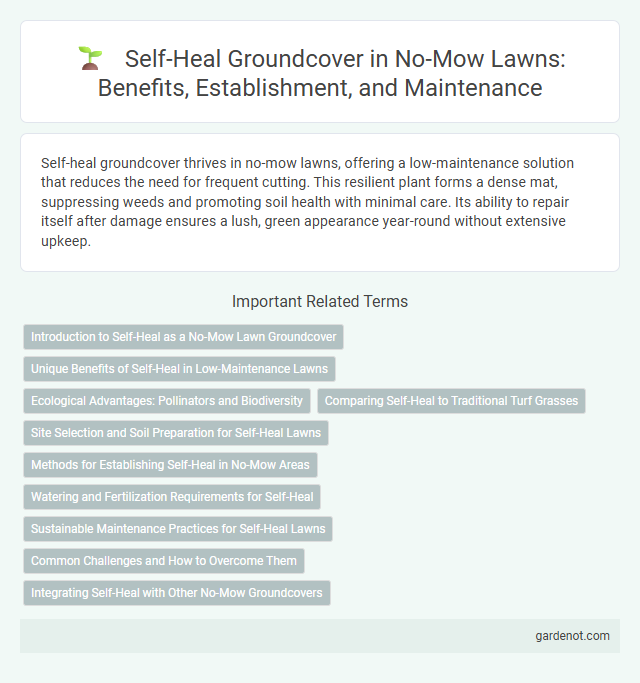Self-heal groundcover thrives in no-mow lawns, offering a low-maintenance solution that reduces the need for frequent cutting. This resilient plant forms a dense mat, suppressing weeds and promoting soil health with minimal care. Its ability to repair itself after damage ensures a lush, green appearance year-round without extensive upkeep.
Introduction to Self-Heal as a No-Mow Lawn Groundcover
Self-Heal (Prunella vulgaris) is an ideal no-mow lawn groundcover, known for its low maintenance and rich green foliage that thrives without regular mowing. This hardy perennial spreads quickly, forming a dense mat that suppresses weeds and tolerates foot traffic in various soil conditions. Its small purple flowers attract pollinators, enhancing biodiversity while creating an attractive, eco-friendly lawn alternative.
Unique Benefits of Self-Heal in Low-Maintenance Lawns
Self-heal groundcover (Prunella vulgaris) offers exceptional resilience and rapid recovery, making it ideal for low-maintenance lawns. Its ability to thrive in various soil conditions while requiring minimal mowing reduces upkeep efforts and supports sustainable landscaping. The plant's dense mat formation suppresses weeds naturally, enhancing lawn health without chemical interventions.
Ecological Advantages: Pollinators and Biodiversity
Self-heal groundcover (Prunella vulgaris) supports pollinator populations by providing abundant nectar and pollen throughout the growing season, attracting bees, butterflies, and other beneficial insects. Its dense, low-growing foliage helps suppress weeds and improve soil health, promoting biodiversity in lawn ecosystems without mowing. Integrating self-heal groundcover into no-mow lawns enhances habitat connectivity and sustains local wildlife, strengthening urban ecological networks.
Comparing Self-Heal to Traditional Turf Grasses
Self-Heal (Prunella vulgaris) outperforms traditional turf grasses by requiring significantly less mowing due to its low-growing, mat-forming habit and natural resistance to pests and diseases. It thrives in diverse soil conditions and provides superior drought tolerance, reducing water usage compared to Kentucky bluegrass or fescue lawns. This groundcover supports pollinators with its small lavender flowers, enhancing biodiversity beyond the purely aesthetic or functional roles of conventional turf grasses.
Site Selection and Soil Preparation for Self-Heal Lawns
Self-heal (Prunella vulgaris) thrives in well-drained soils with neutral to slightly acidic pH, making site selection crucial for optimal growth in no-mow lawns. Soil preparation involves removing debris, loosening the soil to a depth of 4-6 inches, and incorporating organic matter to improve nutrient availability and drainage. Ensuring these conditions helps establish a dense, low-maintenance groundcover that resists weeds and requires minimal mowing.
Methods for Establishing Self-Heal in No-Mow Areas
Establish Self-Heal groundcover in no-mow areas by preparing well-drained, moderately fertile soil with pH levels between 6.0 and 7.5, which promotes vigorous growth. Seed during early spring or late summer to ensure optimal germination at temperatures of 60-75degF, and lightly rake the soil for better seed-to-soil contact. Maintain consistent moisture during establishment while avoiding overwatering to prevent fungal issues, and consider overseeding existing lawns to encourage natural spreading of Self-Heal.
Watering and Fertilization Requirements for Self-Heal
Self-heal (Prunella vulgaris) requires moderate watering, with about 1 inch per week to maintain healthy growth, making it ideal for low-maintenance no-mow lawns. This groundcover thrives in well-drained soil and benefits from balanced, slow-release fertilizers applied once in early spring to support robust development without excessive nitrogen. Minimal fertilization reduces the risk of overgrowth, ensuring Self-heal maintains its dense, green appearance while conserving water resources.
Sustainable Maintenance Practices for Self-Heal Lawns
Self-heal groundcover (Prunella vulgaris) thrives with minimal mowing, making it an ideal choice for sustainable lawn care that reduces water use and chemical inputs. Its dense, mat-forming growth suppresses weeds naturally, promoting a resilient, low-maintenance turf. Incorporating self-heal in no-mow lawns supports biodiversity and soil health, aligning with eco-friendly landscaping goals.
Common Challenges and How to Overcome Them
Self-heal groundcover faces common challenges such as slow initial establishment, susceptibility to drought, and occasional weed invasion. To overcome these issues, ensure proper soil preparation and watering during the first growing season, implement mulch to retain moisture, and use selective hand weeding to maintain groundcover health. Regular monitoring and adjusting care practices promote robust growth and a resilient no-mow lawn.
Integrating Self-Heal with Other No-Mow Groundcovers
Integrating Self-Heal (Prunella vulgaris) with other no-mow groundcovers like clover and creeping thyme promotes a resilient, low-maintenance lawn that requires minimal watering and mowing. This combination enhances soil health by fixing nitrogen and supports pollinators with extended blooming periods. Using diverse groundcovers reduces weed growth and creates a sustainable, drought-tolerant landscape ideal for eco-friendly lawns.
Self-heal groundcover Infographic

 gardenot.com
gardenot.com